The Qualcomm Snapdragon 820 Performance Preview: Meet Kryo
by Ryan Smith & Andrei Frumusanu on December 10, 2015 11:00 AM EST- Posted in
- SoCs
- Snapdragon
- Qualcomm
- Snapdragon 820
GPU Performance
Shifting gears, let’s take a look at GPU performance. As we mentioned earlier, Qualcomm isn’t disclosing much about this GPU other than that it packs quite a bit more computational power than its predecessor and should be quite a bit faster in the process. This points to a potentially significant architectural shift, but that determination will have to wait for another time.
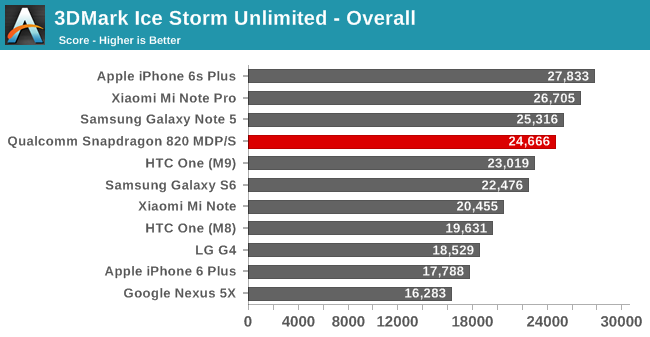
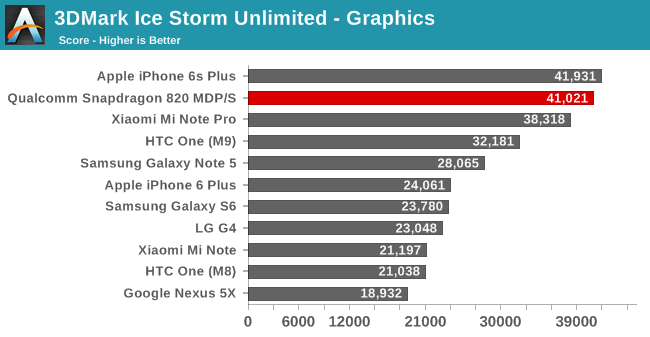
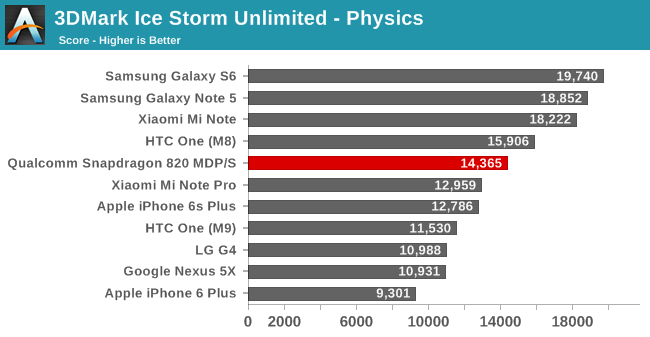
Starting with 3DMark Ice Storm Unlimited, the performance honestly doesn’t start out great. The overall score is significantly influenced by the physics score, which in turn is more concerned with the number of cores and their throughput on simple code than the ability to extract complex IPC. As a result the 4 CPU core 820 simply can’t catch up with the likes of the Samsung devices and their high-clocked big.LITTLE configurations. On the other hand the graphics score makes this the fastest Android phone to date, though relative to the 810 Mi Note Pro, perhaps not by a ton. Ultimately as this is an OpenGL ES 2.x test it’s not the most strenuous of tests these days, and comments from Qualcomm indicate that it may be a CPU-limited test on 820.
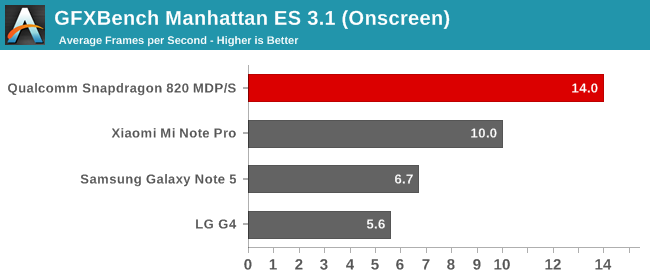
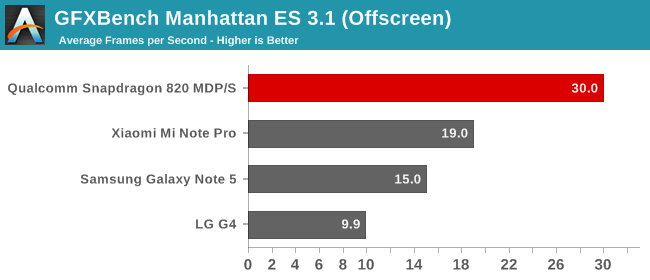
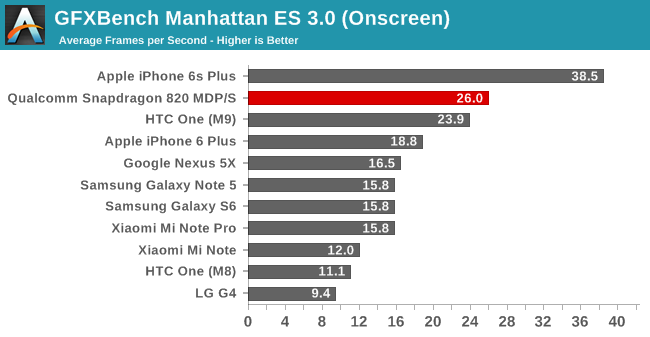
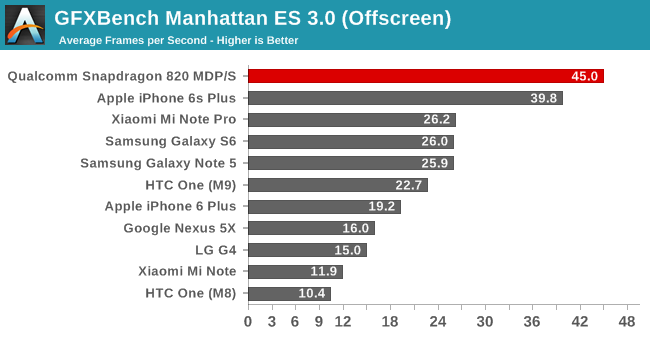
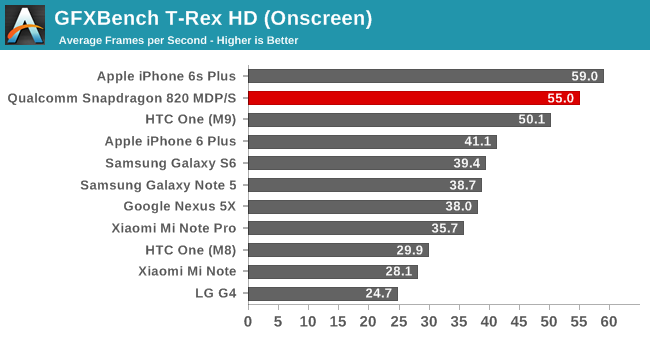
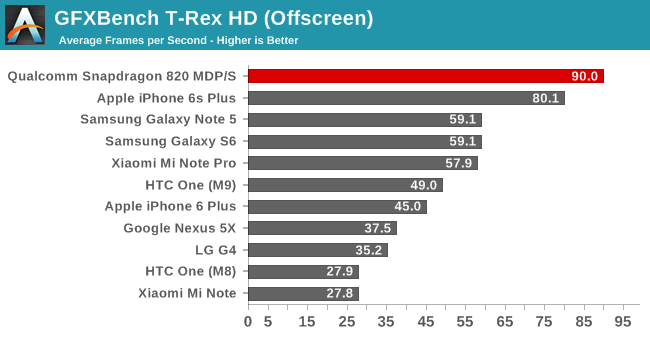
GFXBench on the other hand shows some massive gains for the 820 relative to any other Android device. In offscreen rendering mode, all 3 game tests – Manhattan ES 3.1, Manhattan ES 3.0, and T-Rex HD – put the 820 MDP/S as being 52% (or more) faster than the next-fastest Android device, either the 810 based Mi Note Pro or the Exynos 7420 based Samsung Galaxy Note 5. The single biggest jump we see is with Manhattan ES 3.0 at 72%, while the ES 3.1 version dials that back down to 52%. Even the iPhone 6s Plus, well known for its powerful GPU, is handily and consistently surpassed by the 820 here. Only due to the 6s Plus’s lower rendering resolution of 2208x1242 does it surpass the MDP/S in onscreen tests, as the latter needs to render at 2560x1600 (~50% more pixels). Qualcomm was aiming for some big GPU performance gains here and so far they are delivering.

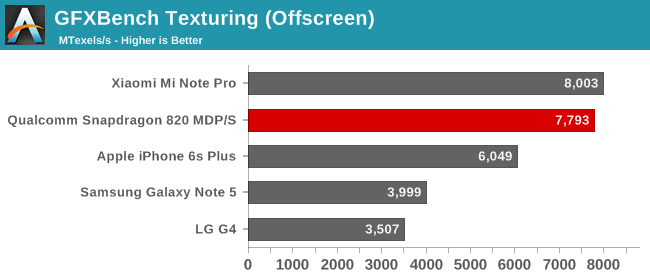
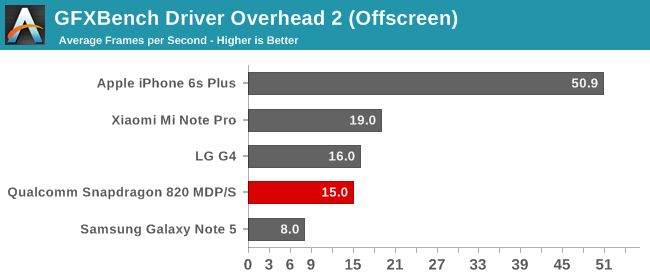
Curiously, GFXBench’s synthetic feature tests don’t show the same gains. Offscreen ALU performance is only slightly improved over the 810 (10%) or in the case of texturing is an outright regression. None-the-less full gaming performance is clearly in the 820’s favor. I’ve long suspected that the Adreno 430 GPU in the 810 had some kind of architectural bottleneck – perhaps an ALU/texture array that was difficult to fully utilize – and what we’re seeing here would back up that claim, as if that was the case then correcting it would have allowed Qualcomm to significantly boost their rendering performance while only barely changing their synthetic performance. Otherwise I find it a bit surprising that the driver overhead score is a bit worse on 820 than 810, which may be a result of the immature GPU drivers on this early device.










146 Comments
View All Comments
extide - Thursday, December 10, 2015 - link
Dude, it has half as many cores. It's a 2+2 design vs a 4+4 design. The fact that is is able to stay close in INteger and actually win in all but one test in FP is actually really good.Although it kinda makes me wish they did a 3+3 design, but oh well, maybe they will in the future.
saratoga4 - Thursday, December 10, 2015 - link
Got to save something for the Snapdragon 825 a year later.alex3run - Friday, December 11, 2015 - link
A9 has still worse CPU performance than Exynos 7420.techconc - Wednesday, December 16, 2015 - link
How so?Thermogenic - Thursday, December 10, 2015 - link
What I'm gathering from these charts is that every 2016 Android smartphone will have lesser performance than the 2015 iPhone, unless Samsung pulls some magic out of their hat with the next version of their chipset.tuxRoller - Thursday, December 10, 2015 - link
Yes, but so what? Apple had had better cpus for several years now. Nothing new here.The more interesting thing is that despite that, Android is still able to keep up with the "highly optimized" "vertically integrated" ios with flagships when it comes to everyday tasks.
MykeM - Thursday, December 10, 2015 - link
http://www.xda-developers.com/marshmallow-reduces-...tuxRoller - Friday, December 11, 2015 - link
....and? I'm aware of android's latency issues (their touch latency is...not good ether).jasonelmore - Friday, December 11, 2015 - link
what good is the performance if it's a sandboxed phone? cant carry around files on the phone, use it as portable computer with flash drive option.Constructor - Saturday, December 12, 2015 - link
That has never been true for iOS either. I've been doing that with my respective iPhones for years by now.There are multiple options for that, but I personally use GoodReader as my generic file system manager on my iPhone and on my iPad. I can expose my files as a mountable network drive and I can also mount remote drives as well. I can also access files on DropBox and similar services from apps directly if I want.
This is not a real issue – nowadays it's mostly just a myth propagated among people who don't know better.